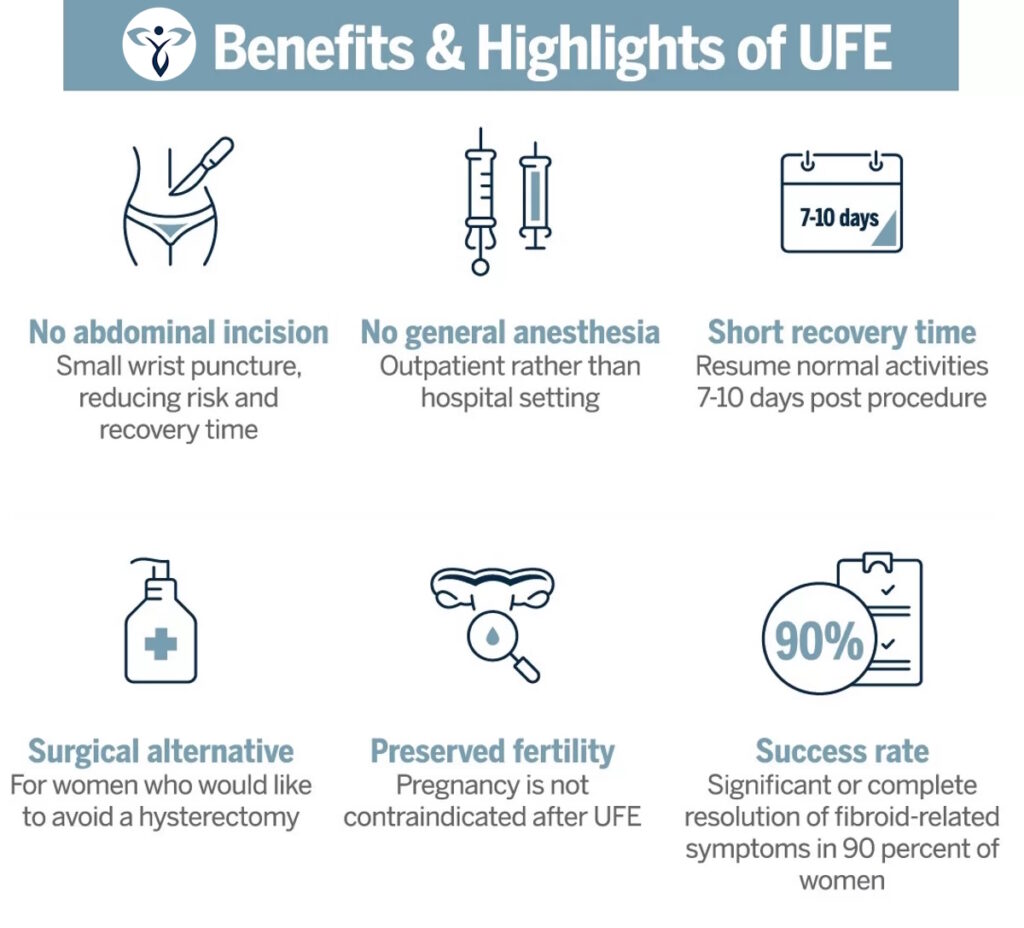When Lynn’s gynecologist told her that she needed fibroid removal to rid herself of the noncancerous tumors causing her heavy and irregular periods, pelvic pain, and constant bloating, she felt both relieved and overwhelmed. On the one hand, she finally had validation that her years of symptoms were not just something to suffer through as part of her menstrual cycles. Then again, the options she was presented with were more than she initially expected. Yes, there is not just one way to treat fibroids—and two of those options include myomectomy and uterine fibroid embolization (UFE). Admittedly, she had indecision on choosing which one was right for her.
Lynn* began reading everything she could and learned quite a bit. Both myomectomy and UFE aim to get rid of fibroid symptoms while preserving the uterus—a gigantic plus for Lynn, since she still desired having more children. That said, each procedure achieved that goal in different ways. One involved surgical incision, which she wasn’t necessarily opposed to, but also meant weeks of recovery and missing work. The other option was minimally invasive, with nothing more than a tiny wrist puncture to show for it. Thousands of women each year face the same decision with fibroid removal: myomectomy or UFE. And which one is best for you depends on several factors.
UFE or Myomectomy: Which Is Right for You?
Myomectomies can get a bad rap because it is fibroid surgery. And while surgery is sometimes necessary—and can be very successful—many women with symptomatic fibroids would prefer to avoid a bloody procedure if possible. That said, a myomectomy is not the same as a hysterectomy. Rather than remove the entire uterus, a myomectomy focuses on taking out only the fibroids causing symptoms while preserving the uterus itself. Depending on how many fibroids are removed, your doctor may also need to reconstruct the uterus to maintain its strength and function.
So, for women who want to keep their uterus, this distinction makes a big difference. And the numbers clearly show their approval. Approximately 30,000 myomectomy surgeries are performed annually, and many patients say they no longer experience fibroid pain and symptoms. There are three types of myomectomies:
- Hysteroscopic Myomectomy — This procedure is less invasive and can be performed on an outpatient basis. But it is only appropriate for patients whose fibroids are in the uterine cavity. Your surgeon will use a thin, telescopic tube to access the uterine cavity before lifting the walls of the uterus to shave off the fibroids.
- Laparoscopic Myomectomy — Only four tiny incisions to the abdominal area are needed to access the uterus, and recovery time is roughly four weeks with minimal scarring. Patients with large fibroids or multiple fibroids deeply embedded in the uterine wall will not benefit from this procedure.
- Abdominal Myomectomy — This procedure requires a long incision in the lower abdominal region and in the area of the uterus where the fibroids are located. Your doctor won’t be as limited with abdominal myomectomies, as they can safely remove deeply embedded fibroids as well as those that are excessively large or in large quantities.

Approximately 30,000 myomectomy surgeries are performed annually, and many patients say they no longer experience fibroid pain and symptoms.
In a matter of one surgical procedure, you can expect to overcome these and other uterine fibroid symptoms:
- Heavy menstrual bleeding
- Debilitating cramps, pelvic pain, and pressure
- Periods that last longer than a week
- Pain during sex
- Back or leg pain
- Urinary frequency
- Weight gain or bloating, and swelling in the abdomen
- Constipation, diarrhea, and rectal discomfort
- Excessive fatigue

Many Women Still See the Downsides of a Myomectomy
Despite these positives, myomectomies are still considered major surgery—requiring anesthesia, incisions (either through the abdomen, laparoscopically, or via the uterus), and several weeks of recovery and absence from your job. Additionally, prospective patients learn there are other potential cons to myomectomy, including but not limited to:
- Surgical risks — Surgery can lead to excessive bleeding, infection, or complications from anesthesia.
- Potential for fibroid regrowth — Since the blood supply is not cut off, new fibroids can develop later.
- Pregnancy variations — Women who undergo this procedure are often advised to have a C-section rather than a vaginal or natural birth. Doing so avoids the potential of uterine rupture during labor.
- Internal scarring — Scar tissue often forms post-surgery and can affect fertility.
Why More Women Are Choosing UFE
UFE is just as effective at eliminating fibroid symptoms, but unlike myomectomy, it is not a surgical procedure. Instead of cutting out fibroids, UFE works by blocking the small blood vessels that feed them. Without this critical blood supply, fibroids no longer have what they need to thrive or grow inside your uterus. As a result, the fibroids shrink, and symptoms begin to fade over time.
Here’s how it works: your interventional radiologist makes a small nick on your wrist and, with help from a catheter, injects tiny particles known as embolic material that block nonessential blood vessels leading to the fibroids. It is a low-risk procedure and is faster than some of the other alternatives.
Rather than there being a hospital stay, UFE is an outpatient procedure:
- No hospital stay
- Can be performed under anesthesia
- No incision; Requires only a tiny wrist puncture.
- No scarring
- No need for vaginal access
- Treat all fibroids at once, regardless of location or size
- Procedure completed under 1 hour
- Patents can go home the same day

How UFE Can Help if a Myomectomy Is Necessary for Fibroid Removal
Depending on your situation, a myomectomy may be the best course of action to help relieve symptoms and pain related to your fibroids. But that does not always completely take UFE out of the picture. More and more doctors today refer their patients to interventional radiologists performing UFE before prior to myomectomy surgery for fibroid removal. With a UFE procedure done beforehand, blood flow to the fibroids is blocked and fibroids start to shrink. With fibroids no longer creating added chaos for the impending surgery, your surgeon’s job is easier, and you receive a better outcome with fewer complications. On top of that, UFE is not another surgery added into the mix.
Some women who undergo UFE find that once their fibroids shrink and symptoms improve, they no longer need additional surgery at all. For others, combining UFE and myomectomy ensures the most complete and efficient fibroid removal possible—offering relief, faster recovery, and better long-term results.

UFE vs. Myomectomy: Comparison Chart
What About Regrowth After Fibroid Removal?
With either myomectomy or UFE, there is a chance for regrowth. In the case of myomectomy since the blood supply is not cut off, new fibroids can develop later in the same areas. With UFE, the recurrence rate is low, especially compared to other surgical options. It is unlikely fibroids will form in the areas where blood supply was stopped.
- Low recurrence – The rate of recurrence after UFE is around 10–20% within five years, which is significantly lower than with myomectomy.
- Slower growth – If fibroids do return in different areas of the uterus after UFE, they often grow back slowly.
- Predictive factors – The size and number of the original fibroids are strong predictors of recurrence. Younger age and family history of fibroids are also risk factors.
- UFE’s goal – The primary goal of UFE is to provide symptom relief by shrinking fibroids. For most women, this relief is long-lasting.
Compelling new research suggests that the risk of fibroid formation and fibroid growth is more prominent in women who display an inflammatory state in the uterus. This can be due to a variety of reasons, including having a diet consisting of high-inflammation foods (red and processed meat, baked goods, deep-fried items, bread, pasta, etc.) versus those that lower inflammation throughout the body (berries, fruits, avocados, nuts, etc.).
With that said, Dr. Ayman Al-Hendy, MD, from the University of Chicago Medicine, stated in an interview that to combat this, women can combine 800 mg of green tea/EGCG with 5,000 mg of Vitamin D each day. From his clinical trial featured in the New England Journal of Medicine, doing so has been shown to reduce new fibroid formation for women who do not yet have fibroids but are considered high-risk, AND women who previously underwent a UFE or myomectomy procedure and wish to prevent further disease progression.
It is advised that women combine 800 mg of green tea/EGCG with 5,000 mg of Vitamin D each day. Doing so has been shown to reduce new fibroid formation.
Fibroid Institute Is Your Source for UFE Over Myomectomy
Women are more educated than ever about their fibroid treatment options. Yes, myomectomy and hysterectomy surgeries are still options many doctors suggest. However, UFE is quickly becoming the gold standard—especially when considering that it is non-surgical, offers faster recovery times, and yields effective outcomes. Not to mention, it can make surgical procedures easier if that is the best option for your unique fibroid removal journey. A fibroid specialist can help you weigh the pros and cons of all options and create a treatment plan tailored to you.

The only decision left is to choose the right interventional radiologist to provide UFE. Beyond the procedure itself, women want a doctor who provides access, communication, comfort, innovation, trust, and a supportive experience from start to finish. Fibroid Institute Texas is here to do just that.
At Fibroid Institute, we set the standard of care for advanced fibroid treatment, helping women achieve a fibroid-free life. We specialize in UFE because it delivers exceptional results in the least amount of time and with limited pain. On top of that, we simplify your UFE journey, managing everything from insurance to PCP communication and offering all patients physician-direct cell phone access before and after their procedure.
With multiple locations, our Dallas and Houston fibroid clinics help thousands of women avoid fibroid surgery and find relief from their fibroid symptoms. Our fibroid doctors are board-certified interventional radiologists and experts passionate about helping women.
Request a free 10-15-minute phone screening to determine if you are eligible. If you qualify for UFE after the screening, you can schedule your on-site or telehealth consultation. Most major medical insurance providers cover the cost of UFE. Get started now in Dallas at 214-838-6440, in Houston at 713-903-3733 or complete the form below. We are dedicated to helping you become #FibroidFree.
Before starting any new treatment or if you have questions regarding a medical condition, always seek the advice of your doctor or other qualified health provider. This information is not a substitute for professional medical advice.
Fibroid Institute Texas serves the Dallas and Houston areas including Garland, Mesquite, Richardson, Dallas, Sherman, Houston, Sugar Land, Katy, Webster, Clear Lake, The Woodlands, Universal City, Spring, Kingwood, Stafford, Conroe, Texas City, Cypress, League City, Bellaire, Addison, Carrollton, Plano, Frisco, Craig Ranch, McKinney, Allen, Fort Worth, Grand Prairie, Hurst, Euless, Bedford, Arlington, Hutchins, Irving, Duncanville, DeSoto, Cedar Hill, Lancaster, Cockrell Hill, Highland Park, University Park, Park Cities, and more.
*Patient names and/or photos may be changed to protect patient confidentiality.

